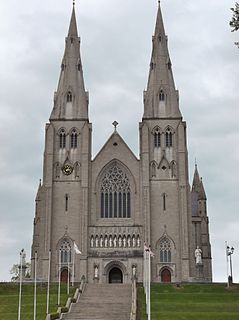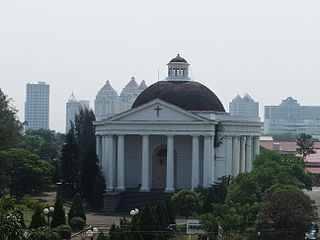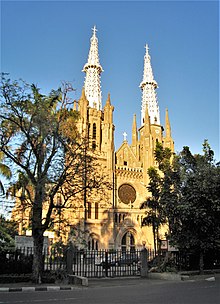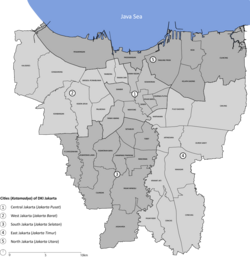
Istiqlal Mosque in Jakarta, Indonesia is the largest mosque in Southeast Asia and the sixth largest mosque in the world in terms of worshipper capacity. Built to commemorate Indonesian independence, this national mosque of Indonesia was named "Istiqlal", an Arabic word for "independence". The mosque was opened to the public on 22 February 1978. Within Jakarta, the mosque is positioned next to Merdeka Square and the Jakarta Cathedral and also of the Immanuel Church.

St. Patrick's Cathedral in Armagh, Northern Ireland is the seat of the Catholic Archbishop of Armagh, Primate of All Ireland. It was built in various phases between 1840 and 1904 to serve as the Roman Catholic Cathedral of the Archdiocese of Armagh, the original Medieval Cathedral of St. Patrick having been appropriated by the state church called the Church of Ireland at the time of the Irish Reformation.

Zagreb Cathedral, on the Kaptol, is a Roman Catholic cathedral-church and not only the second tallest building in Croatia but also the most monumental sacral building in Gothic style southeast of the Alps. It is dedicated to the Assumption of Mary and to kings Saint Stephen and Saint Ladislaus. The cathedral is typically Gothic, as is its sacristy, which is of great architectural value. Its prominent spires are considered to be landmarks as they are visible from most parts of the city. One of its two spires was damaged in an earthquake that took place on March 22, 2020.

Eduard Cuypers was a Dutch architect. He worked in Amsterdam and the Dutch East Indies.

Saint Mary's Cathedral is the cathedral parish of the Catholic Diocese of Austin located in Austin, Texas, United States. It was listed on the National Register of Historic Places in 1973, as St. Mary's Cathedral.

The Cathedral of the Immaculate Conception of the Holy Virgin Mary is a neo-Gothic Catholic Church at Moscow's center, that serves as the cathedral of the Catholic Archdiocese of Moscow. Located in the Central Administrative Okrug, it is one of three Catholic churches in Moscow and the largest in Russia.

The Cathedral of the Virgin Mary, Queen of the Holy Rosary, also known as the Holy Rosary Cathedral or Randusari Cathedral is a Roman Catholic cathedral and the seat of the Archdiocese of Semarang. Finished in 1927 at Randusari, Semarang, Indonesia, it became a parish church in 1930 and a cathedral in 1940, when Albertus Soegijapranata was made the first archbishop of Semarang.

St. Joseph's Church, also known as Gedangan Church, is a Catholic church in Semarang, Indonesia, the first such church in the city. Administratively, it is part of the St. Joseph's Parish in the Archdiocese of Semarang.

Medan Cathedral is a Roman Catholic Cathedral in Medan, Indonesia. The current cathedral was inaugurated in 1928. It is one of the Dutch colonial buildings in Medan.

Bandung Cathedral is a Roman Catholic Cathedral in Bandung. Its official name is Katedral Santo Petrus. It is located at Jalan Merdeka, Bandung, Indonesia. The building was designed by Wolff Schoemaker in Neogothic style. Bandung Cathedral has a land area of 2,385 m2 and building area of 785 m2.

Immanuel's Church is a Protestant church in Jakarta, Indonesia. It is considered one of the oldest churches in Indonesia. It stands on the corner of Jalan Medan Merdeka Timur and Jalan Pejambon, part of the 19th century's Weltevreden district, renamed and transformed into Gambir. The church is the only one in Jakarta that conducts some of its services in Dutch. It also performs services in Indonesian and English.

The GPIB Paulus Jakarta, officially known as the Gereja Protestan di Indonesian Bagian Barat "Paulus", Jakarta, is a Reformed church located in Menteng, Jakarta, Indonesia.

Bogor Cathedral, formally the Cathedral of the Blessed Virgin Mary, is a historic church building in the Roman Catholic Diocese of Bogor in Bogor, West Java, Indonesia.

The Holy Family Cathedral is a religious building of the Catholic Church in Banjarmasin in the province of South Kalimantan, Indonesia. It was designed by architect Roestenhurg in a neo-Gothic style.

The Cathedral of Saint Mary the Eternal Helper, also called Samarinda Cathedral or Paroki Katedral Samarinda, is a parish of the Roman Catholic Church in Samarinda, East Kalimantan, Borneo, Indonesia. It is the mother church and seat of the Metropolitan Archdiocese of Samarinda, under the pastoral responsibility of Archbishop Justinus Harjosusanto.

Johannes Martinus (Han) Groenewegen was a Dutch architect who was active in the Netherlands and the Dutch East Indies, and subsequently, Indonesia from the 1920s to the 1960s.
The St. Mary Assumpta Cathedral also called Tanjung Selor Cathedral, Is a Catholic Church located in the city of Tanjung Selor, a district in the regency of Bulungan in the province of Kalimantan of the North to the northeast of the island of Borneo in Indonesia.

Paledang is one of the areas in Central Bogor District, Bogor, West Java, Indonesia. It encompasses the Bogor Botanical Gardens and Istana, plus a bustling urban area to the west between the Gardens and the river. Bogor Paledang railway station serves the Bogor-Sukabumi route.
Tunnel of Friendship, or Tunnel of Silaturahmi is an underground tunnel connecting the interior of Istiqlal Mosque and St. Mary of the Assumption Cathedral in Jakarta, Indonesia.The tunnel was constructed as part of the plan to renovate the mosque, and the construction was started on 15 December 2020. It took around 10 months to be finished and was finished in September 2021.




























